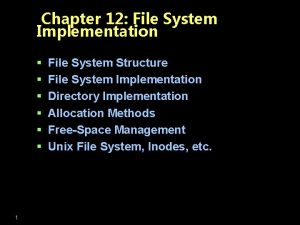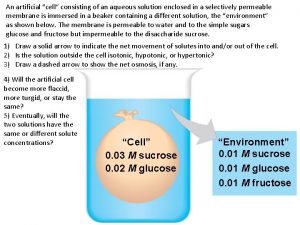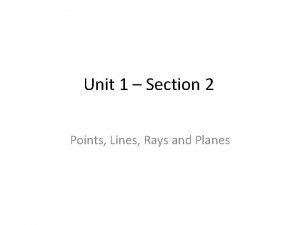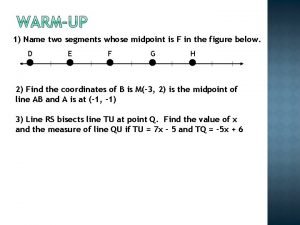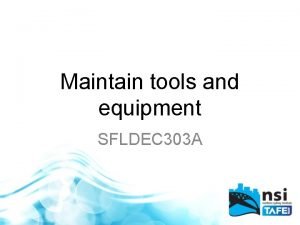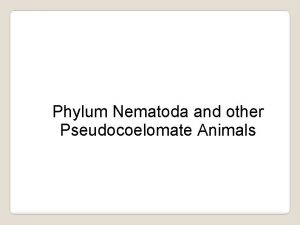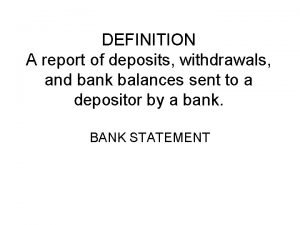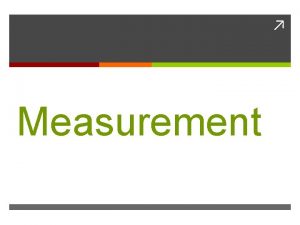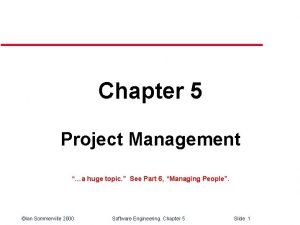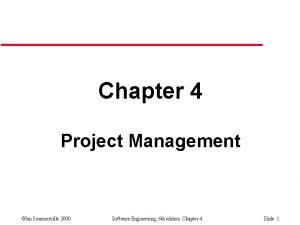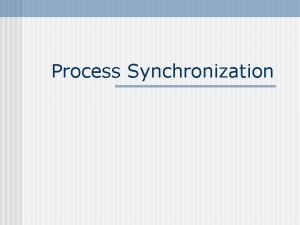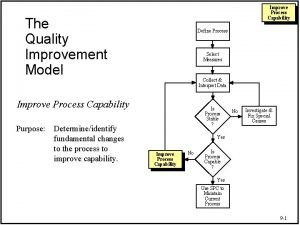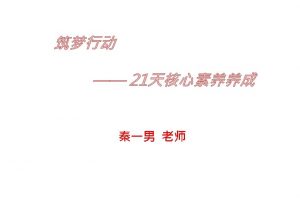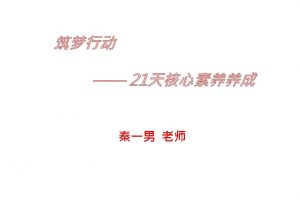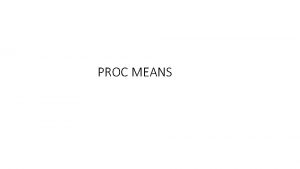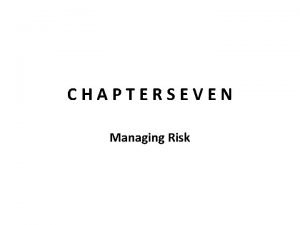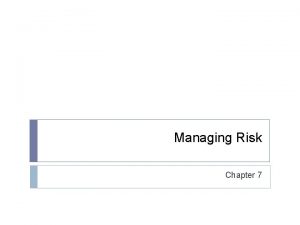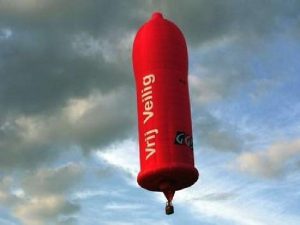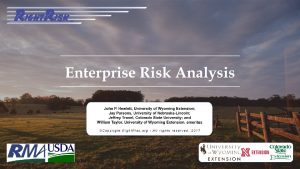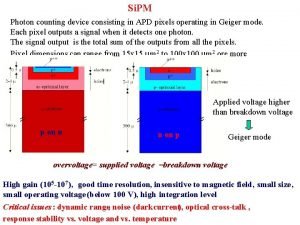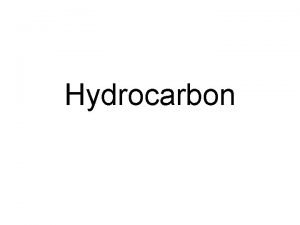RISK ANALYSIS Risk analysis means a process consisting




























- Slides: 28

RISK ANALYSIS

Risk analysis means a process consisting of three interconnected components: • Risk assesment • Risk managment • Risk communication

Risk Analysis system • Risk assesment means a scientifically based process consisting of four steps: hazard (agent) identificacion, hazard characterisation, exposure assesment and risk characterisation. • Risk management means the process for selecting appropriate prevention and control options. • Risk communication means the interactive exchange of information and opinions through the risk analysis process.

Operators Responsibilities • Food business operators shall ensure at all stages of production, processing and distribution that foods satisfy the requirements of food law. • Food operators shall be able to identify any person from whom the have been supplied with food or any substance intended to be incorported into a food.

Traceability System Traceability means the ability to trace and follow a food, feed, food producing animal or substance intended to be or expected to be incorporated into a food or feed, throug all stages of production, processing and distribution. http: //ec. europa. eu/food/foodlaw/traceability/factsheet_trace_2007_en. pdf

Why is important Traceability? • The identification of the origin of food ingredients and food sources is of prime importance for the protection of consumers. • Traceability facilitates the withdrawal of unsafe food. • Identify and document information on product “one step forward and one step back” in the food chain.

Risk Assesment Clasification of traders acording to risk factors • Company (Type, size, activity, quality department) • Produce (SMS /GMS) • Campaing (Volumen, evolution) Traders fall into red, amber or green categories or “Exempted trader” (Auditing system) Programme of visits Different visit frequencies Inspectors give priority to high risk traders Inspection records entered directly into SOIVRE database system Problems found on visits to traders are taken into account in trader clasification. • Surveillance based on signal, dissapointing results. • •

The risk analysis: a double risk classification The criteria considered to assess risk are: q (initial check frequencies) § Position of traders in the marketing chain. § Efficiency of the self checking systems. § Size of the traders (volume marketed). q (final check frequencies) § Findings made during previous checks. § Exceptional circumstances.

The risk analysis: the size classification Traders are classified in three groups, based on the annual volume of commercialized products (estimated marketing capacity): q Less than 3. 000 tm/campaign or per year. q Between 3. 000 and 25. 000 tm/campaign or per year. q More than 25. 000 tm/campaign or per year (higher level of risk).

The risk analysis: self checking system classification The existence and efficiency of a self checking system determines four levels of risk: q Type A. Minimum risk. (Approved traders) q Type B. Unapproved traders with quality control department which permits documentary auditing. q Type C. Unapproved traders with an appointed head of quality control. q Type D. Other traders: unapproved or non registered traders, or traders without an appointed head of quality control (high risk).

The risk analysis: risk level and check frequency Five levels of risk determining five frequencies of checks: q Minimum, 1 visit per year. q Greatly reduced, 1 visit every 6 months. q Reduced, 1 visit every 3 months. q Medium, 1 visit per month. q High, 1 visit every 15 days.

The risk analysis: changes in the initial frequency q Internal factors: trader’s particular record (situations that only affect a single trader). q External factors: specific situations which affect to one or more products and/or specific markets.

The risk analysis: changes in the initial frequency External factors that affect the produce: q Initial or closing periods of the campaign q Specific problems related to a product or to a specific origin q q (pesticides, negative publicity campaigns, etc. ) Adverse climatic circumstances in origin (frosts, intense rains, heat waves, etc. ) Pest and diseases which seriously affect the quality Serious problems at the destination markets (oversupplying, decline in consumption, etc. ) Problems with transport and/or distribution (strikes…)

The risk analysis: changes in the initial frequency Internal factors (trader’s particular record): q If there have been the following findings of NCN, § § § 2 or more NCN (< than 3000 tm/campaign) 4 or more NCN (3000 – 25000 tm/campaign) 6 or more NCN (> than 25000 tm/campaign) q the trader involved will pass to the check frequency immediately above.

The risk analysis: return to the initial frequency The trader will return to the previous initial frequency: q automatically, when 3 or more conformity checks without negative results have occurred, or q through a motivated decision by the competent inspection body: § § at an individual or collective level, or when the marketing campaign has been concluded.

Conformity controls at export and import level q The conformity certificate is compulsory for customs clearance, both for import and export from/to third countries. q But it is not possible to check every consignment for conformity. q As a general rule, the basic check frequency is: Minimum % of conformity checks (physical) Import Export 80 % 50 %

Conformity controls at export level q The initial minimum frequency of physical controls is based on the type of trader according to its self checking quality system: Minimum % of consignments for conformity checks (physical) Frequency of visits allocated to the trader Type A (Approved traders) Types B, C, D (Unapproved traders) Minimum Greatly reduced Reduced 60% 70% Medium High 70% 100%

Conformity controls at export level q The final frequency of physical controls is based on the type of product: Minimum % of consignments for conformity checks (physical) High perishable Perishable Less perishable Products with specific marketing standard 90% 70% 60% Products with general marketing standard 80% 60% 50%

Conformity controls at import level q The criteria to asses the risk include the country of origin and the type of product. q Regarding the country of origin, the existence of a conformity certificate issued by a third country where the conformity checks have been approved by the Commission (art. 15), is a factor that reduces the risk of non conformity. Minimum % of conformity checks (physical) Approved country + certificate Other 80 % 100 %

Conformity controls at import level q The final frequency of physical controls is based on the type of product: Minimum % of consignments for conformity checks (physical) High perishable Perishable Less perishable Products with specific marketing standard 95% 85% 75% Products with general marketing standard 85% 75% 55%

APPROVED TRADERS

Implementing Regulation (UE) No 543/2011 The risk analysis: approved traders (art. 12) To become an approved trader it is necessary to: q have inspection staff who have received appropriate training; q have suitable equipment for preparing and packing produce; q commit themselves to carry out a conformity check on the goods they dispatch and have a register recording all checks carried out.

Implementing Regulation (UE) No 543/2011 The risk analysis: approved traders (art. 12) q Traders providing special guarantees on conformity to marketing standards are classified in the lowest risk category. q Approved traders may use the specimen in Annex II in the labelling of each package at the stage of dispatch.

RISK ANALYSIS SOFTWARE SUPPORT TOOLS

Software support tools GARFYH: the Risk Analysis application

Implementing Regulation (UE) No 543/2011 The risk analysis: risk level and frequency of checks


Thank you for your attention.
 Credit risk market risk operational risk
Credit risk market risk operational risk 14 line sonnet poem
14 line sonnet poem Film genre comedy
Film genre comedy A storage structure consisting of information about a file
A storage structure consisting of information about a file An artificial cell consisting of an aqueous solution
An artificial cell consisting of an aqueous solution A part of a line consisting of two endpoints
A part of a line consisting of two endpoints Another word for two
Another word for two X = 10 6 5
X = 10 6 5 Tools and equipment
Tools and equipment Phylum nematoda anatomy
Phylum nematoda anatomy The human being is an entity consisting of
The human being is an entity consisting of Sternberg triarchic theory
Sternberg triarchic theory An endorsement indicating a new owner of a check.
An endorsement indicating a new owner of a check. Poly means many and gon means
Poly means many and gon means Metamorphic rocks
Metamorphic rocks Meta and morph means
Meta and morph means Biodiversity conservation definition
Biodiversity conservation definition Bio means life logy means
Bio means life logy means Cigital's architectural risk analysis process
Cigital's architectural risk analysis process Frap risk assessment
Frap risk assessment Type of risk
Type of risk Risk analysis
Risk analysis Process synchronization means
Process synchronization means Improving process capability means;
Improving process capability means; Risk projection
Risk projection Risk avoidance insurance
Risk avoidance insurance Absolute risk vs relative risk
Absolute risk vs relative risk Residual risk and secondary risk pmp
Residual risk and secondary risk pmp Inherent risks examples
Inherent risks examples



